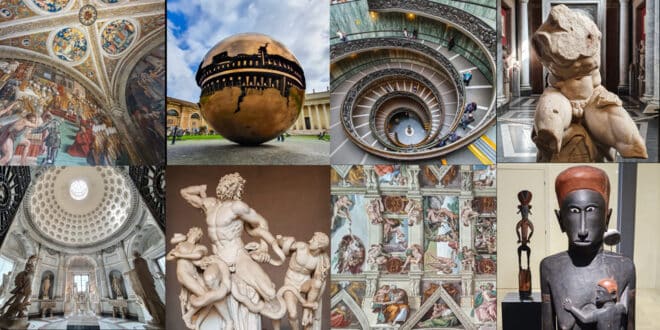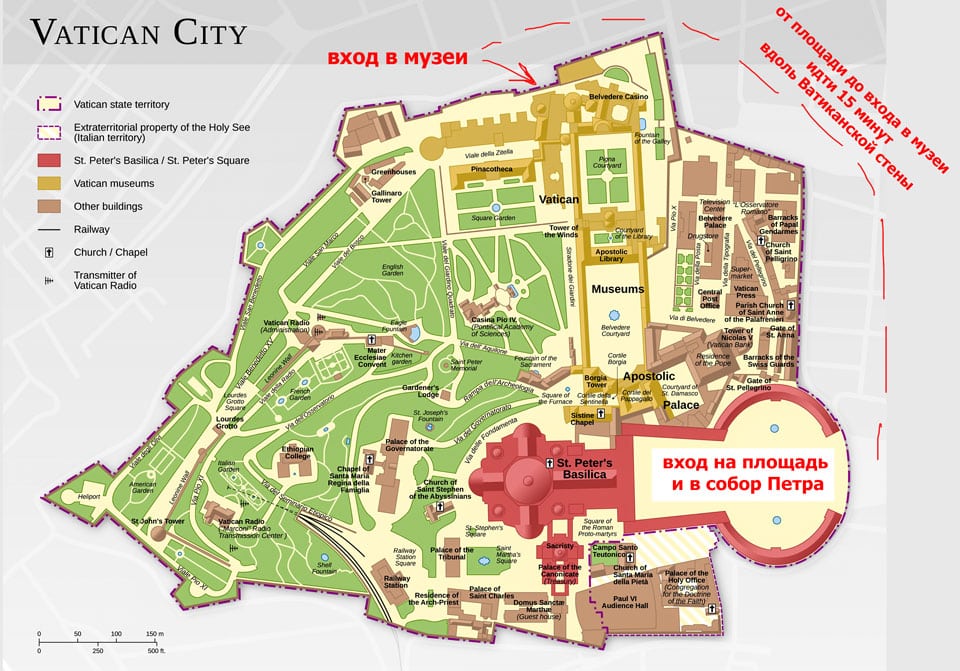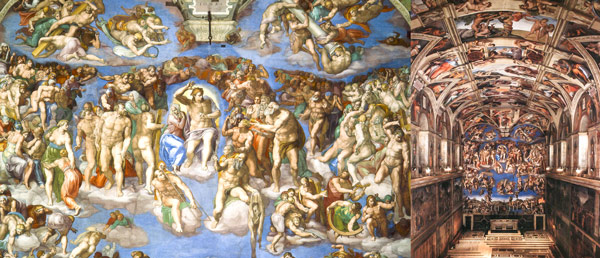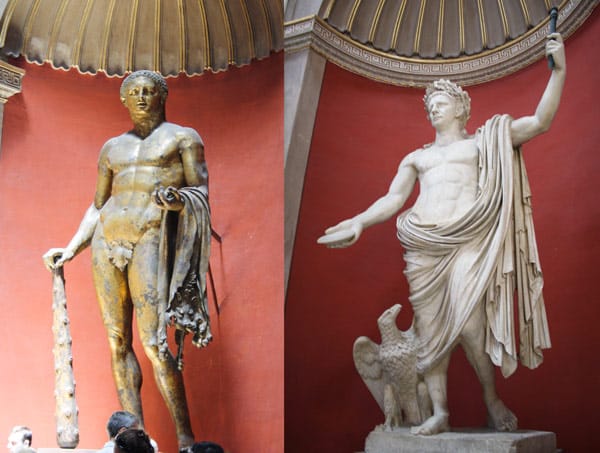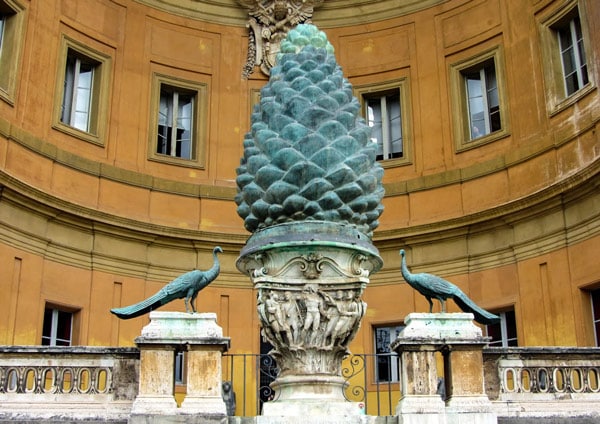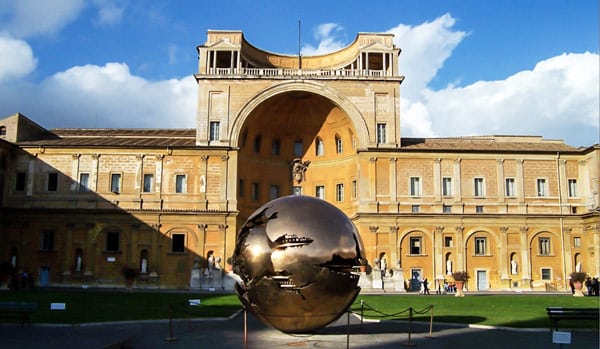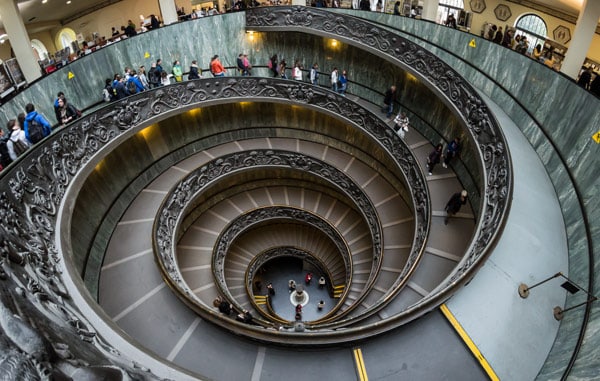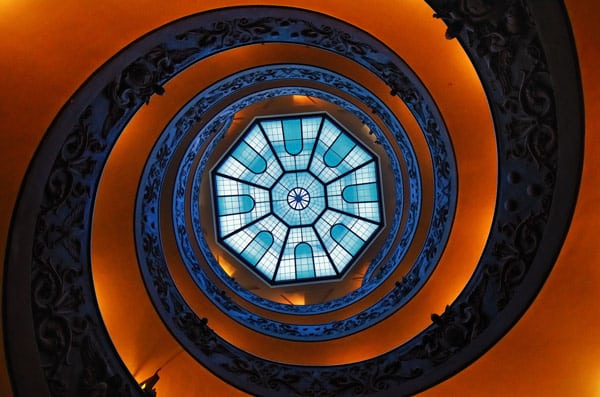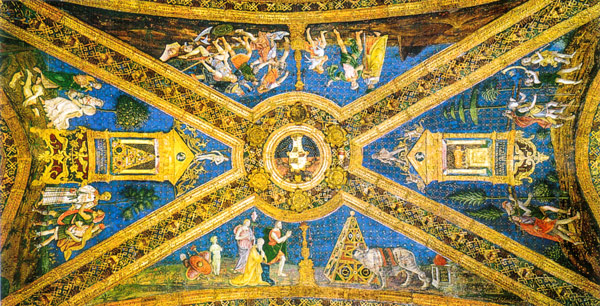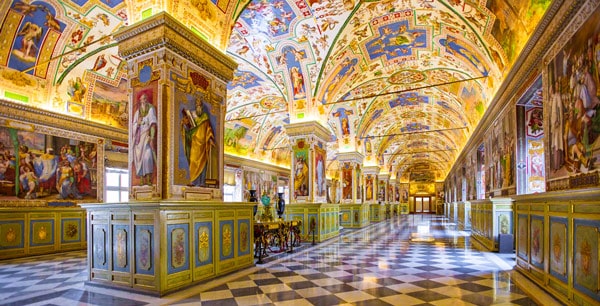Under the comprehensive sign “Vatican Museums” (Musei Vaticani), a myriad of exhibition halls and galleries are concealed. The oldest exhibits date back five centuries. Over time, the museum curators have amassed an astonishing collection of sculptures, paintings, manuscripts, everyday objects, and religious art.
Only within the splendid settings of the Vatican palaces can one fully appreciate these masterpieces of world art.
Page Contents
Tips Before Visiting the Vatican Museums
Let’s start by addressing some common questions from tourists:
You can spend more than a day exploring the Vatican Museums. At a minimum, you should plan out which exhibits and halls you want to see. A standard solution could be an audio guide, but ideally, you should opt for a professional guide’s accompaniment.
How to Buy Tickets to the Vatican Museums
Vatican Museums’ Opening Hours: 08:30 AM to 06:00 PM from Monday to Saturday. The ticket offices selling tickets are open until 04:00 PM. Visitors are required to leave the museum halls half an hour before closing time.
The influx of tourists results in enormous queues for tickets. One good way to avoid hours of waiting is to use instructions and the official Vatican website tickets.museivaticani.va, which is available in English or Italian. See step-by-step instructions for purchasing tickets to the Vatican Museums yourself.
The full ticket price is €17, and an additional €4 for pre-booking the ticket will pay off in time saved. Tourists can also use an audio guide containing 400 mp3 files with useful but dull information about all the Vatican’s attractions. The audio guide rental costs €7.
Vatican Museums’ Operating Hours in 2024
With the calendar below (image is clickable), you can plan your visit to the Vatican Museums in 2024. Operating schedule: every day except Sunday, from 08:30 AM to 05:00 PM.
Free Admission Days at the Vatican Museums
Dates highlighted in green are the last Sundays of each month when admission to the museums is free – visiting these days is not recommended due to huge queues and crowds inside the halls.
If you don’t mind crowds, queues, and heat, then arrive to queue up at 08:00 AM, an hour before opening on these dates. In 2024, the free admission days are as follows:
- January 28
- February 25
- April 28
- May 26
- June 30
- July 28
- August 25
- September 29
- October 27
- November 24
- December 29
The last visitor is admitted at 12:30 PM; those who don’t make it in time will have waited in line for nothing.
On these dates, visiting the museums with a professional guide from the “Italy for Me” team is impossible.
Evening Visits on Fridays and Saturdays in 2024
In 2024, the museums will be open in the evenings on Fridays and Saturdays from March to the end of December. The operating hours are extended by 1 hour. We are already [accepting applications](https://gid.italy4.me/contact/); don’t delay, as the number of tourists wishing to visit on a tour with a licensed guide in the evening always exceeds the number of good guides.
Closed Days
Besides Sundays, in 2024, the Vatican Museums will be closed on the following dates:
- January 1 and 6
- February 11
- March 19
- April 1
- May 1
- June 29 (Feast of Saints Peter and Paul)
- August 14 and 15
- November 1
- December 25 and 26
Also, in 2024, it’s a bad idea to visit the museums on the dates January 2, 3, 4, and 7, March 18, 20, and 21, May 2 and 4, June 26-27, July 1, August 13 and 17, December 23, 24, and 27-28, as these are dates adjacent to major religious holidays when the museums are closed, leading to increased demand. Be prepared for massive crowds inside and the absence of tickets at the ticket offices about 4 weeks in advance.
Location of the Entrance and Ticket Offices of the Vatican Museums
Before visiting the Vatican Museums, studying the map provided below is advisable. The map shows the museum entrance – note that it is about a 15-minute walk from St. Peter’s Square.
Facing the cathedral, head to the left along the Vatican wall to reach the ticket offices. Halfway there, you will see a queue; if you haven’t booked tickets online, join the line, and after a few hours, you can enter the museums.
If you have already purchased tickets in advance, head straight to the entrance, show your reservation to the guard, and collect your tickets at the ticket office.
Read on for tips on how to get to the Vatican.
History of the Vatican Museums
In the 15th century, the famous Sistine Chapel (Cappella Sistina) was built in the Vatican. Architect Giovanni di Dolci created a modest church building, which was internally adorned by Renaissance masters: Sandro Botticelli, Domenico Ghirlandaio, Cosimo Rosselli, and Pietro Perugino. A separate highlight of the chapel is Michelangelo di Lodovico’s (Michelangelo) fresco “The Last Judgment.”
At the end of the 15th and the beginning of the 16th centuries, another architectural and artistic monument emerged in the Vatican territory – the Borgia Tower (Torre dei Borgia). Pope Julius II initiated the tradition of collecting exquisite items. In the 16th century, he began actively collecting Roman copies of ancient sculptures and organized a suitable space for his exhibition.
In the early 20th century, the Vatican (Stato della Città del Vaticano) established itself as a sovereign state. The Lateran Treaty secured the rights and freedoms of the papal authority. All the collected art pieces became the property of the Catholic Church. However, the same document obliged the church to open its exhibitions for all visitors.
So, what should a self-guided tourist definitely see in the Vatican Museums besides the Sistine Chapel?
Belvedere Courtyard (Cortile del Belvedere)
Throughout the 16th century, Pope Julius II reconstructed existing palaces. Consequently, under the direction of architect Donato Bramante, the Belvedere Courtyard was formed based on the palaces of Innocent VII and Nicholas V.
The architecture of the buildings is a magnificent example of the High Renaissance era. Its classical beauty is complemented and highlighted by exhibits: the ancient statue of Apollo, the architectural group Laocoön and His Sons, the Perseus by Antonio Canova, the Belvedere Torso, and the statue of the Aphrodite of Knidos.
Pio-Clementino Museum (Museo Pio-Clementino)
All these wonders are displayed in the inner courtyard of Belvedere – the Pio-Clementino Museum. Pope Clement XIV, who reigned in the 1770s, was the conceptual inspiration for collecting these art pieces. His successor, Pius VI, also did not neglect the museum. The Pio-Clementino Museum boasts eight halls in total.
Gregorian Egyptian Museum (Museo Gregoriano Egizio)
Another fascinating exhibition is located on the upper floors of the Belvedere – the Gregorian Egyptian Museum. The first exhibits were collected by Pope Pius VII, but the museum was organized by his successor, Gregory XVI, in 1839. The nine halls showcase revered Egyptian items from the 3rd century BCE. The most popular pieces include the headless statue of priest Ujahorresnet, statues of pharaohs, sarcophagi, ancient mummies, and canopic jars. Separate halls are also dedicated to the cultures of Mesopotamia and Syria.
Courtyard of the Pine Cone (Cortile Della Pigna)
In the Courtyard of the Pine Cone, visitors can observe unusual outdoor exhibits: a gigantic pine cone adorning a fountain and a large bronze sphere. The pine cone-decorated fountain is an ancient symbol of life.
Meanwhile, the sun-gleaming bronze sculpture “Sphere within a sphere” (Sfera con sfera) represents the life of modern man. This installation, created by Arnaldo Pomodoro (Arnaldo Pomodoro), was installed in the Vatican in 1990 thanks to the efforts of Pope Paul II. The four-meter-tall external bronze sphere is situated on the lawn of the Belvedere, with a smaller sphere rotating inside it.
The pattern on the inner sphere is visible through the gaps and ruptures in the outer shell. In this way, the architect depicted a modern symbol of life – the Earth surrounded by the Universe. Everything Earth’s inhabitants do to their planet is transmitted to the outer world.
Read also about Pope Francis.
Pinacoteca
The Vatican’s painting collection has had a complicated history: soon after Pope Pius VI announced his collection in the late 18th century, Napoleon’s troops carted away the best works to Paris. It took 20 years for these masterpieces to return, albeit in a rather sorry state. Today, the Pinacoteca boasts around 460 works that narrate the evolution of painting from the primitive medieval style to the 19th century.
Museums of the Apostolic Palace (Palazzo Apostolico)
The entrance to the Vatican Museums begins with an unusual attraction – the spiral staircase designed by architect Giuseppe Momo. This dizzying spiral staircase appeared in 1932. The independent radii of the staircase and its railings allow you to encompass the entire building with your gaze!
Moreover, the ram’s horn-twisted descent initially has a flat surface that gradually transitions into steps. So, after conquering this marvelous staircase, visitors will have access to 7 kilometers of corridors and passages leading to 1,400 halls filled with 60,000 priceless exhibits.
Raphael’s Rooms
Three large and bright rooms in the northern wing of the Apostolic Palace are known as Raphael’s Rooms. In Italian, “stanza” means “room.” Thus, travelers will be amazed by three rooms painted by the unquestioned Renaissance genius – Raphael Santi (Raffaello Santi).
The rooms have individual names, according to the theme of the frescoes: Room of the Segnatura (Stanza della segnatura), Room of Heliodorus (Stanza di Eliodoro), and Room of the Fire (Stanza dell’Incendio del Borgo). Adjacent to the rooms is a vast space – the Hall of Constantine (Sala di Costantino).
Borgia Apartments
Part of the Palazzo Nicholas V houses the Borgia Apartments (Appartamento Borgia) – the quarters of Pope Alexander VI.
In the late 15th century, during the pope’s lifetime, the vaults of the apartments were painted by renowned Renaissance artists Pinturicchio and Bramante. The walls and ceilings of the halls are adorned with images of prophets, medieval sciences, and biblical stories.
Gregorian Etruscan Museum (Museo Gregoriano Etrusco)
The Gregorian Etruscan Museum, founded in 1837, offers a journey into Italy’s past. The Etruscans, ancient inhabitants of the Apennines, reached their zenith in the 8th century BCE. The museum boasts a rich collection of artifacts from Etruscan culture, religion, and daily life. In its 22 halls, visitors can see statues, bronze items, carved stones, and ceramics.
- Recommended reading about: National Etruscan Museum of Villa Giulia.
Vatican Apostolic Library (Bibliotheca Apostolica Vaticana)
Scholarly visitors to the Vatican will find the Vatican Apostolic Library intriguing. Access to specialists is possible only by appointment made several months in advance.
Founded by Pope Nicholas V in 1475, the library’s collection has grown over six centuries to include about 1.6 million printed books. There are around 150,000 manuscripts, as many engravings, a vast collection of geographical maps, awards, medals, coins, tapestries, and even candlesticks! All exhibits are carefully preserved and restored as needed.
Initially, the Vatican Library served as an archive for necessary documentation. Over time, its collections expanded with rare editions. The wall and ceiling frescoes by Ghirlandaio, Melozzo da Forlì, and Romano (Antonio Aquilio) are particularly captivating. Some visitors even believe that entire halls filled with prohibited literature are hidden from the public eye.
 Italy for me From Italy with love
Italy for me From Italy with love

